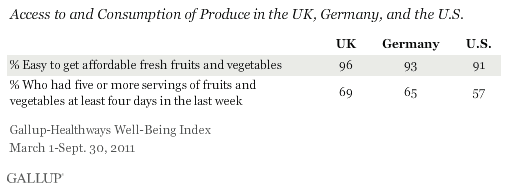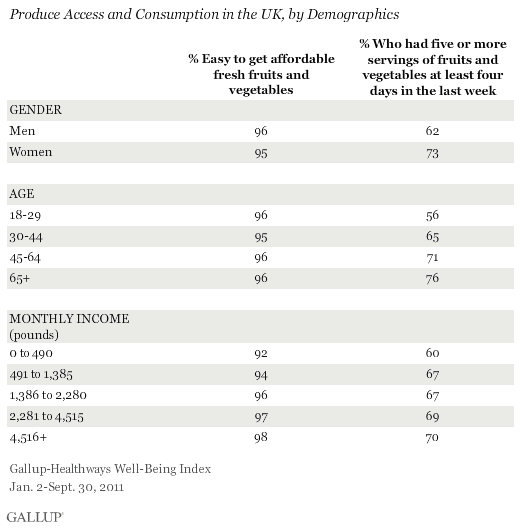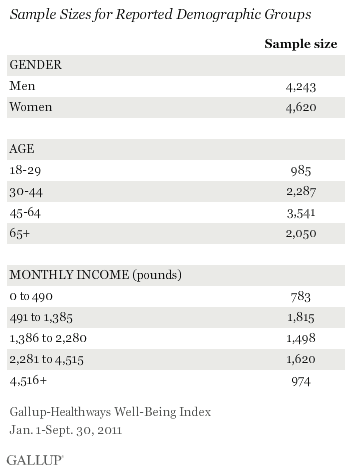WASHINGTON, D.C. -- Britons have slightly better access to fruits and vegetables and consume more of them than do Germans and Americans.

These data are based on Gallup-Healthways Well-Being Index surveys collected in the U.K., Germany, and the U.S. March 1 through September 30, 2011. Gallup and Healthways ask approximately 1,000 Britons and Germans each month and 1,000 Americans every day about their eating habits.
Specifically, Gallup asks respondents to report on how many days in the last seven they had five or more servings of fruits and vegetables and if in the city or area where they live it is easy or not easy to get affordable fruits and vegetables.
In the UK, Those With High Incomes, Women, and Seniors Consume Most Produce
High-income Britons are more likely to say it is easy to get affordable fruits and vegetables and more likely to consume them frequently, compared with their low-income counterparts. About 7 in 10 Britons in high-income households report eating at least five servings of fruits and vegetables at least four days each week, but this falls to nearly 6 in 10 among the lowest income households.
Some of the variance in Britons' consumption of produce could be related to household income and the ability to afford it. While high-income households have near-universal access (98%) to affordable fruits and vegetables, this is true of 92% of those in the lowest income bracket.

Women and those aged 65 and older are more likely to consume fruits and vegetables than are men and those younger than 65. However, easy access to affordable produce is about the same across all demographic groups.
These demographic and socio-economic patterns in fruit and vegetable access and consumption are similar in the U.S.
Bottom Line
Britons are doing better than Germans and Americans in consuming healthy amounts of fruits and vegetables. Britons' better eating habits compared with Americans' may be part of the reason obesity and chronic condition rates are lower in the U.K. than they are in the U.S.
High-income Britons have better access to and consume more produce than their low-income counterparts, indicating that better access to fresh fruits and vegetables may result in increased consumption. These data suggest that health leaders in the government and businesses in Britain could increase healthy produce consumption by focusing on improving low-income Britons' access to fresh fruits and vegetables.
About the Gallup-Healthways Well-Being Index
The Gallup-Healthways Well-Being Index tracks well-being in the U.S., U.K., and Germany and provides best-in-class solutions for a healthier world. To learn more, please visit well-beingindex.com.
Survey Methods
Results are based on telephone interviews conducted as part of the Gallup-Healthways Well-Being Index survey Jan. 2-Sept. 30, 2011, with a random sample of 8,863 adults, aged 18 and older, living in in the United Kingdom, selected using random-digit-dial sampling. For inter-country comparisons, this story uses data captured from March 1-Sept. 30, 2011. During this period, Gallup surveyed 6,893 Britons, 6,768 Germans, and 211,232 Americans.
For results based on the total sample of national adults in the U.K., one can say with 95% confidence that the maximum margin of sampling error is ±1.2 percentage points.
For U.K. adults sorted by demographic groups, the margin of sampling error is as high as ±3.8 percentage points. The table lists sample sizes by demographic groups.

Interviews are conducted with respondents on landline telephones and cellular phones. Each daily sample includes a minimum quota of 5 cell phone respondents and 29 landline respondents, with additional minimum quotas among landline respondents for gender within the regions. Landline respondents are chosen at random within each household on the basis of which member had the most recent birthday.
Samples are weighted by gender, age, education, region, adults in the household, and cell phone status. Demographic weighting targets are based on the most recently published population data from the Census Bureau for Northern Ireland, Scotland, England, and Wales. All reported margins of sampling error include the computed design effects for weighting and sample design.
In addition to sampling error, question wording and practical difficulties in conducting surveys can introduce error or bias into the findings of public opinion polls.
For more details on Gallup's polling methodology, visit https://www.gallup.com/.
